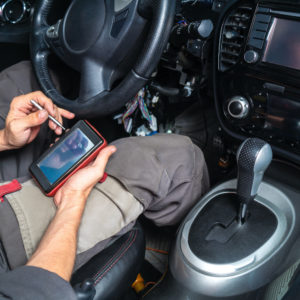Diagnostic trouble codes (DTCs) are set when there’s a problem with your car. The codes fall under four categories: powertrain, body, chassis, and network connection. Those starting with “P” are classified under the powertrain category and are often set when there’s a mechanical or electrical failure with various systems involving the engine or transmission.
Fixing a code is not easy, as it requires a deep understanding of the issue. If your scan tool registered the P0151 code, this guide will provide you with the essential things you should know for troubleshooting.
What Does the P0151 Code Mean?
Diagnostic trouble code (DTC) P0151 stands for “O2 Sensor Circuit Low Voltage (Bank 2, Sensor 1). It means that the oxygen sensor’s voltage has remained lower than factory specifications for a certain amount of time.

The code P0151 is similar to P0136, P0137, and P0131. This code warns about a fault with the upstream oxygen sensor on Bank 2. Bank 2 Sensor 1 is tucked in front of the catalytic converter. It analyzes the amount of oxygen in the exhaust before it enters the catalytic converter. The PCM uses this information to adjust the vehicle’s air-fuel ratio.
To improve emissions, car manufacturers equip cars with three-way catalytic converters, which recombines toxic compounds into safer emissions through a chemical process.
The PCM constantly tests the catalytic converter by comparing the voltage signals of the upstream and downstream O2 sensors. If the system detects that the upstream sensor’s signal is lower than specifications, it recognizes it as “O2 Sensor Circuit Low Voltage.” The PCM will immediately illuminate the check engine light and set the P0151 code.
You can find more helpful technical information in our in-depth discussion about oxygen sensors and DTCs.
Note: The definition of code P0151 may be different depending on the vehicle manufacturer. Consult the appropriate repair manual or repair database for the exact code definition.

What are the Possible Causes of Code P0151?
There are multiple factors that could cause the activation of the engine code P0151. Below are its most likely causes:
- A faulty front O2 sensor (bank 2)
- An issue with the O2 sensor’s circuit
- A lean running condition
- An exhaust leak
What are the Common Symptoms of the P0151 Code?
If you’re reading the P0151 code on your OBD scanner, you have a high chance of experiencing these symptoms:
- Illuminated check engine light
- Abnormally high fuel consumption
- Engine performance problems, such as rough running and poor acceleration
How to Diagnose the P0151 Code
There are different ways of diagnosing the OBD code P0151 as there different causes that could trigger it. There is no universal diagnosis as cars are not built to look and operate the same. It would be very helpful to consider consulting a certified mechanic for you to avoid committing expensive mistakes.
How to Fix the P0151 Code
Clearing the P0151 code can be challenging as there are various causes and symptoms. If you don’t have the proper DIY skills and knowledge about the code, it is recommended that you let licensed mechanics handle the job for you.
If you’re confident of your knowledge about this specific DTC code, you can address it by using online auto repair resources and guides like ALLDATA. An ALLDATA subscription will give you access to a huge database of information about various faults in your vehicle. Remember to verify key information about your vehicle before proceeding to diagnostics and troubleshooting using the repair manual.
Where to Get a New Oxygen Sensor for Your Ride
If your OBD scan tool reads a P0151 code, you’re possibly dealing with a bad front oxygen sensor in bank 2. Once you’ve confirmed this, have this particular oxygen sensor replaced as soon as possible. Luckily, you can easily find a top-notch oxygen sensor here at CarParts.com.
Our website offers a great selection of oxygen sensors that come as direct-fit replacements for a wide range of make and models. Simply go to our website and look for our vehicle selector. Input your ride’s specific details, and check out the right oxygen sensor replacement for your vehicle.
All our products come with a low-price guarantee, so you don’t have to break the bank just to get an oxygen sensor for your ride. Plus, they are sourced from top brands in the industry. You don’t have to worry about functionality because they work just like your factory unit.
Need parts delivered as soon as possible? Our distribution centers are strategically located across the country, so you can expect your order to arrive in just a few days.
Don’t ruin your trip all because of a bad oxygen sensor. Check out our selection and order today!
Products Mentioned in this Guide
Shop this Project




Any information provided on this Website is for informational purposes only and is not intended to replace consultation with a professional mechanic. The accuracy and timeliness of the information may change from the time of publication.



 Catalytic Converter
Catalytic Converter
 Oxygen Sensor
Oxygen Sensor
 Engine Control Module
Engine Control Module




















